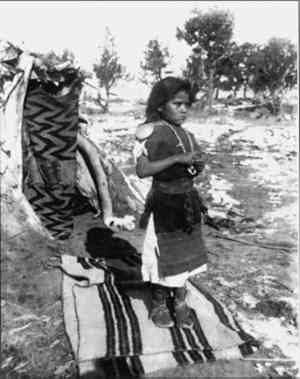WOVEN BY THE GRANDMOTHERS: TWENTY-FOUR BLANKETS TRAVEL TO THE NAVAJO NATIONSUSAN HEALD, & KATHLEEN E. ASH-MILBY
1 INTRODUCTIONThe National Museum of the American Indian (NMAI), Smithsonian Institution, like other museums in North America, is seeking consultation, collaboration, and partnership with Native American communities in its research, exhibitions interpretation, and collections care (NMAI 1992). Through the Navajo textile project, we sought to meet this goal by traveling a selection of textiles to the Navajo reservation in 1995. The project culminated in the exhibition and publication Woven by the Grandmothers: Nineteenth-Century Navajo Textiles from the National Museum of the American Indian(Bonar 1996). Although NMAI actively lends objects to tribal museums, cultural centers, and occasionally to Native communities for ceremonial use, this project marked the first time the museum took collections objects back to the Native community that created them to develop an exhibition. As an outreach program, our priorities included providing the Navajo community access to this collection through a public display and a hands-on workshop. The workshop, in particular, was an opportunity for Navajo weavers to closely examine these early blankets. This type of increased use of collections can challenge traditionally accepted museum standards that guide collections care. NMAI is continually balancing the need to preserve and safeguard its collection while providing access and educational opportunities to the public, especially the Native community. Over the past two decades museum professionals, including conservators, have begun to integrate sensitivity issues related to indigenous cultural materials with standard museum practice. The proceedings of Symposium '86: The Care and Preservation of Ethnological Materials (Barclay et al. 1986), contain several papers in the “Conservation in the Cultural Context” section that describe museum collaborations with indigenous peoples from the Americas. Subsequent thematic conservation conferences and symposia have raised the awareness of museum professionals working with these types of collections.1Moses (1995) explained the importance of recognizing traditional Native views concerning object preservation, which may be quite different from traditional European views. For instance, some Native views do not support the indefinite preservation of all material culture but allow for its natural deterioration. Native opinions about the preservation (or nonpreservation) of material vary from culture to culture. Opposing views are sometimes found among members of the same tribe and may change over time (as within scholarship).2Clavir (1996) discussed the challenges that museum professionals, specifically conservators, face when indigenous cultural material in a museum is viewed by Native people as part of a living culture rather than part of a historic past. In these cases, preservation of the object may go beyond physical preservation and encompass cultural and even spiritual realms of preservation. The NMAI's collection of 19th-century Navajo textiles has special historical significance to the Navajo community. Woven in the mid- to late 19th century, many of these textiles were made as clothing for everyday and special use, while others were made as utility blankets that served a variety of purposes (fig. 1, p. 336). With the restriction of the Navajo to reservation life after their confinement at Bosque Redondo (1864–68), the materials, design, and use of later weaving underwent a dramatic change (Kent 1985; Hedlund 1996; Wheat 1996). For instance, later blankets were not as finely woven and were made primarily for trade to non-Indians. Prereservation blankets in good condition, such as in the NMAI's collection, had largely been removed from the reservation by the end of the 19th century by traders and dealers to be sold into the Indian art market. While collecting did help preserve these old blankets, it has also made them inaccessible to many Navajo people. Now many of these textiles are in collections outside of the Navajo Nation and are frequently regarded as two-dimensional art objects.
|
